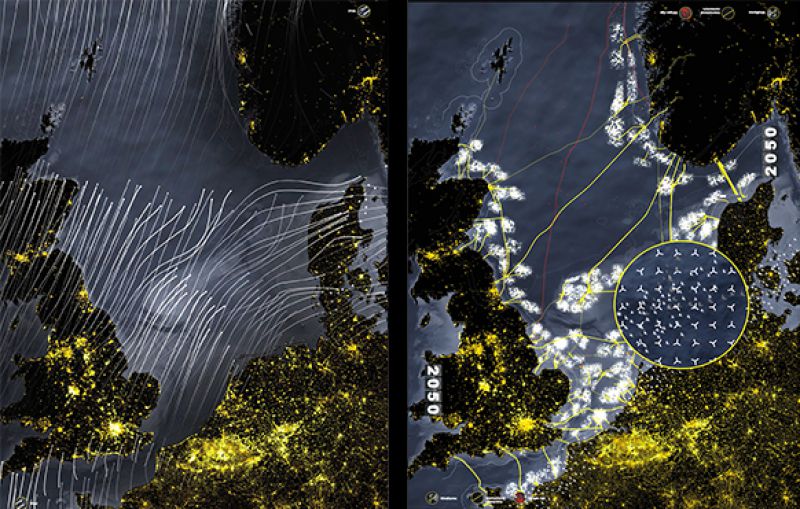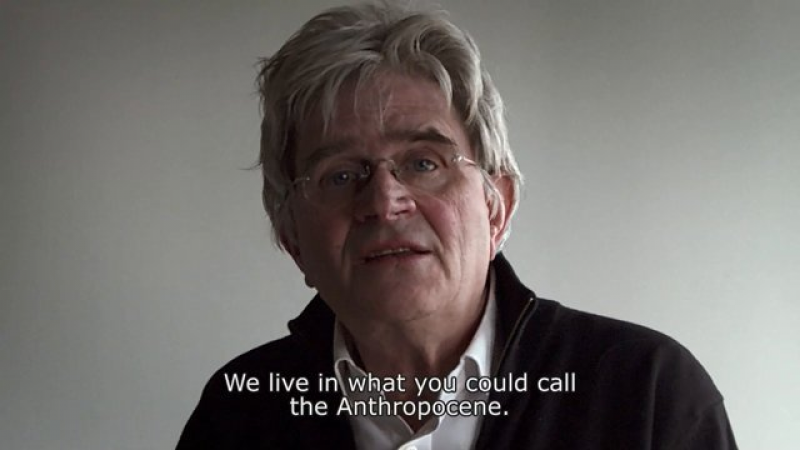Dirk Sijmons (1949) studied Architecture at Delft University of Technology and is one of the three founders of H+N+S Landscape Architects. Dirk Sijmons was awarded the Rotterdam-Maaskant Prize in 2002. In 2004, Dirk Sijmons was appointed Governmental Advisor on Landscape by the Minister of Agriculture, Nature Management and Fisheries. In 2007, he received the prestigious Edgar Doncker prize in the category of ‘true Dutch culture’. Sijmons was also a Professor of Landscape Architecture at Delft University of Technology.
Most weekdays, starting at 12:30 hours, it's High Noon at the biennale.
Today, Dirk Sijmons, curator of IABR–2014–URBAN BY NATURE and one of the founders of H+N+S Landscape Architects, among many other things, and Berno Strooman, Chief Government Advisor on the Built and Rural Environment, on the tension between ecology and agriculture. After the two presentations, they will enter into a public debate moderated by Dutch Government Architect and IABR-curator Floris Alkemade.
location: HAKA Building
date: June 27
time: 12:30 - 2 pm
language: Dutch
IABR–Atelier 2050 - An Energetic Odyssey
The North Sea and energy transition

© IABR, Tungsten Pro
The European climate objective – 80 to 95 percent reduction of greenhouse gas emissions in 2050 compared with 1990 – requires significant system changes. The IABR–Atelier 2050 – An Energetic Odyssey shows how far-reaching the energy transition from fossil fuels such as oil, coal, and gas to an energy supply largely fed by renewable energy sources actually is. It is a (spatial) task that is still largely underestimated. On land, we will have to pull out all the stops in terms of energy saving, central and decentral initiatives with solar panels, wind, bio mass, geothermal heat, residual heat, and so on. Even making a maximum effort, this will prove inadequate. 2050 – An Energetic Odyssey represents a system leap that makes it possible to bridge this gap by the very large-scale production of wind energy on the relatively shallow North Sea for the countries that surround it.
Transition
The IABR–Atelier 2050 demonstrates what such an ambitious approach involves, what infrastructure it requires, what it means to link up with the nature of the North Sea, what role the entrepreneurial state plays, which innovations this requires, and especially which new economic dynamic this will generate, for instance in the offshore sector.
Research by design will facilitate this transition of imaginaries. The aim of the installation is to create a reference point for a broad dialogue between public and private parties and a new, appealing step towards the realization of large scale production, transportation, and storage of renewable energy on and around the North Sea. Development perspectives are outlined on the basis of a robust future scenario.
After IABR–2016–THE NEXT ECONOMY the installation has been reformatted. Click here to see the video
Towards a clean economy
The title of the project, 2050 – An Energetic Odyssey, is meant to provoke. Many people underestimate the scale of the challenge and think that the transition can take place with the support of small-scale projects alone (small is beautiful). However, the goal agreed upon worldwide – to limit global warming to 1.5 to 2 degrees – also requires more large-scale and drastic changes of the system. The good news is that, in principle, the production of North Sea energy can meet the demand. 2050 – An Energetic Odyssey shows that the Next Economy can be a clean economy.
IABR with the Ministry of Economic Affairs, Van Oord, Shell, TenneT, Zeeland Seaports, European Climate Foundation, Natuur & Milieu, RWE, Port of Rotterdam Authority and Port of Amsterdam.
Concept: Maarten Hajer and Dirk Sijmons
Research by design and animation by H+N+S Landscape Architects, Ecofys and Tungsten Pro
THE ENERGY TRANSITION: A CALL FOR NEW DESIGN PRACTICES
The transition towards an energy-neutral society is one of the major challenges of the coming decades. And a goal that the international community has committed itself to after signing the Climate Change Agreement in Paris. The transition towards renewable energy will have an enormous spatial impact. How do we develop shared perspectives on the desired outcomes? What is the role of national governments and cities? And can designers take the lead in researching, testing and imagining the paths to possible solutions?
with Dirk Sijmons (H+N+S Landscape Architects), Roeland van der Schaaf (Alderman in Groningen), Pallas Agterberg (Director Strategy, Alliander), Isabelle Vries (Senior Strategist, Port of Rotterdam) and Rick Bosman (researcher DRIFT).
TUESDAY 24 MAY
Time: 7.30 - 9 p.m.
Location: Fenixloods II, Paul Nijghkade 19, Rotterdam
Language: Dutch
Admission fee: none.
A reservation in advance is highly recommendable and can be made here.
On six Tuesday evenings, RUIMTEVOLK and the IABR will highlight the issues raised by the quest for the Next Economy. How do designers, administrators, and professionals, active on the local, regional, national or international scale, tackle the issues the IABR–2016 raised: the energy transition, the healthy city, and the productive city? How can designers contribute to the reduction of the spatial separation between the disadvantaged and the winners, to a more inclusive city? How can design contribute to an urban economy that adds local value and is circular? In short, which are the concrete Next Steps for design, planning, and governance?
The opening of the exhibition THE NEXT ECONOMY on 23 April also marks the beginning of ten weeks of discussion and exchange about the future of the city. WHAT'S NEXT? starts on Saturday afternoon with an introduction by IABR-director George Brugmans, a speech by Rotterdam's mayor Ahmed Aboutaleb, and three panel discussions, guided by Maarten Hajer, on the three main themes of IABR–2016: the productive and inclusive city, the healthy and cooperative city, and the green sustainable city.
There is also a continuous program of presentations by guests of and participants in the IABR 2016.
1 pm approx: Panel 1: THE PRODUCTIVE AND INCLUSIVE CITY
In cities there is a renewed interest in a local manufacturing economy. New opportunities are provided by the emergence of smart technologies, the ambition to develop a circular economy, reshoring (bringing manufacturing back home), and an increasing public demand for (local) craftsmanship. How can spatial quality and the urban economy reinforce one another, and who creates and benefits from a productive city? And how do we connect new dynamics to the existing informal economy?
With, among others, Jeanne van Heeswijk (artist and founder of the Freehouse Foundation and the Afrikaanderwijk Cooperation in Rotterdam), Fernando de Mello Franco (architect, currently the City Councilor of Urban Development of São Paulo, and member of the Curator Team of the 5th IABR: Making City) and Daan Zandbelt (partner De Zwarte Hond and Lead Designer of the IABR–Atelier Rotterdam Productive City).
2:30 pm: Panel 2: THE HEALTHY AND COOPERATIVE CITY
Even in the Netherlands life expectancy between people living in different neighborhoods of the same city areas can differ up to 13 years. While people get older and care gets more expensive, retirement and nursing homes are closing down. This second panel is about the relationship between health and urban development. How do cities cope with the retreat of institutional care? Will we survive being left dependent on cooperation or should governments and health insurers reconsider their roles and take a share of the responsibility? And how can the healthy city in the Next Economy be healthy for everyone?
With, among others, Joachim Declerck (partner Architecture Workroom Brussels and Lead Designer of the IABR–Atelier Utrecht) and Pauline Meurs (Professor of Health Care Governance at Erasmus University Rotterdam and Chair of the Council for Health and Society) and Victor Everhardt (Alderman for Public Health and Deputy Mayor of the Municipality of Utrecht).
4 pm: Panel 3: THE GREEN AND SUSTAINABLE CITY
What needs to happen if we would be truly serious about the 2 degrees climate goal? The European climate objective – 80 to 95 percent reduction of greenhouse gas emissions in 2050 compared with 1990 – requires significant system changes, but it also opens up new economic vistas. Which spatial conditions would support such an economy? Is a climate neutral city really feasible, and how could design make a contribution? How to connect small-scale initiatives to large companies that are part of the old system? And is there something we could learn in this respect from Africa?
With, among others, Eglantina Gjermeni (Minister of Urban Development of Albania, and responsible for Atelier Albania), Nienke Homan (Regional Minister of Energy Transition and Environment of the Province of Groningen, and co-commissioner of the Atelier Groningen), Mark Swilling (member of UNEP’s International Resource Panel and Distinguished Professor in Sustainable Development at the University of Stellenbosch, Cape Town) and Dirk Sijmons (one of the founders of H+N+S Landschapsarchitecten, emeritus professor of Environmental Design at TU Delft and curator of IABR–2014–URBAN BY NATURE).
Saturday 23 April 2016
Time: 12 noon - 6 pm
Locatie: Fenixloods II, Paul Nijghkade 19, Rotterdam
Language: English
Reservation for the opening weekend is not possible, tickets are available at the box office.
Tickets for the panels and the Next Salon are available at the box office an hour before the start of the program. Please note that there is a limited number of seats available.

6"08'
© iabr/UP, 2014
Dirk Sijmons, curator of IABR–2014–URBAN BY NATURE: "If we want to address the real and oppressive issues of the urban planet of the twenty-first century, a moralistic message that amounts to saying that we humans have gone too far and therefore have to reverse course is of little use. There is no going back. Welcome to the Anthropocene!"
This film is one of a series of short videos commissioned by the IABR for its sixth edition, IABR–2014–URBAN BY NATURE.
director: Alexander Oey
producer: George Brugmans
